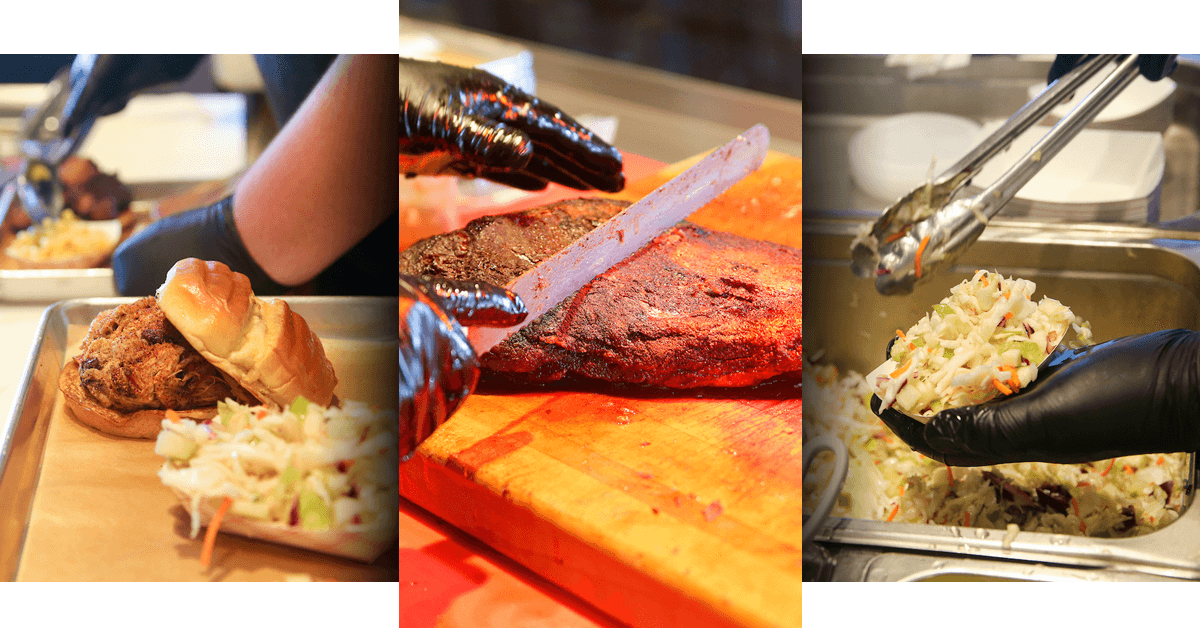In order to become Denver’s BBQ restaurant of choice, GQue had to walk the BBQ walk—and talk the talk, too. BBQ, much like other forms of cooking, has a lot of nomenclature that isn’t used anywhere else.
If you missed out on Part 1 of our glossary of BBQ terms, there’s no need to worry. Here’s another heaping helping of some common (and not-so-common) BBQ terms.
Au Jus
A gravy made of meat juices. Au Jus is usually paired with the meat that it came from because, well, that’s where the richest meat flavor comes from.
Banking Coals
The act of pushing your coals to one side on a charcoal grill.
Bear Paws
A meat-shredding instrument that looks a lot like bear paws. The largest bear claws on the planet can be as large as chef’s knives, which was the inspiration for the development of this essential BBQ tool.
Burping (or Belching)
Opening and closing grill and smoker vents to release heat and pressure. In some smokers, if pressure isn’t released and the grill is opened, a pressurized fireball, called a flashover, will fly out and BBQ your eyebrows. Also, the act of releasing air from your stomach via the mouth. This usually happens from eating just enough BBQ.
Flavortown
Coined by Guy Fieri, Flavortown is a spiritual destination that is only visited when eating something meaty, saucy, and downright delicious. While we don’t necessarily endorse the methods, opinions, or cooking advice of Mr. Fieri, we hope you find your way to Flavortown.
Free Range
A marketing term used to describe animals who have an outer pen or “range” where they are allowed to freely graze and wander. It’s usually the more ethical approach to raising animals.
Gastrique
A type of BBQ sauce, usually made from vinegar and sugar. When the sugar is cooked, it burns and caramelizes, creating a sticky, sweet, and acidic sauce.
Gristle
Tendons that connect muscle to bone. Also known as the elastic, rubbery bits on your meat that are difficult to chew.
The Itis
A completely colloquial and unscientific term used to describe what happens when you eat too much meat. This ailment causes sleepiness, flatulence, and an overall sense of euphoria.
Lard
Pork that has been melted and solidified. Often used in baking, and in some countries, as a butter substitute.
Marinade
A mixture of liquid and spices for soaking meat. This process can infuse meats with extreme juiciness and flavor.
Money Muscle
The penultimate piece of pork butt, located on the outside edge of the butt. It’s juicy and flavorful on the inside, and forms a crunchy and aesthetically pleasing bark on the outside. Possibly the best piece of pork you’ll ever have in your life.
Peeking
When you open the lid of the grill or smoker to “peek” at your meat. If you feel like peeking, run in the other direction. This is a cardinal sin of BBQ and cooking in general.
Purge
When meat releases its inner liquids out of the meat. For packaged meat, the longer it sits, the more liquid it will purge. This can be a problem, because you want all that juice and flavor to be inside of your meat. Moral of the story: buy the freshest meat possible for the best texture, flavor, and moisture.
Slather
Throwing a thick layer of sauce or glaze on your meat. Slather it on, my friend.
Spatchcock
A method of cooking poultry that involves removing bones and flattening the meat. When flat enough, the bird cooks very easily, and can develop a nice, crispy exterior.
Suet
Beef fat that is commonly ground into hamburger meat. Provides added salty flavor.
Tallow
Suet which has been melted, strained to remove impurities, and solidified. Often used for high-temperature baking and frying, and a key ingredient in many natural soaps and skin softening products.
Hopefully, these terms will help you speak the language of an experienced BBQ pitmaster. Check out our most recent blog posts to learn more about BBQ cooking and culture, and stay tuned for the third course of our glossary of BBQ terms!

